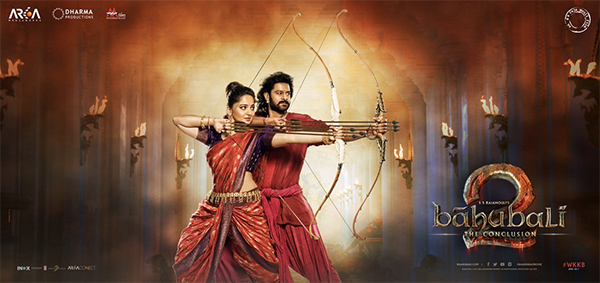Since 2015, there’s been one question lurking in the mind of most of the people – be it a kid, teen, adult or a senior citizen. And finally today, after almost 600 days of anticipation and waiting, the answer is out there, waiting for it to be discovered in the theatres. By now, you might have guessed what I am referring to. Yes, it’s that million dollar question around which the whole hype has been built by the filmmakers. I am talking about the famous dialogue from Baahubali : The Beginning movie – ‘Katappa ne Baahubali ko kyu maara?’ (Why did Katappa kill Baahubali)
While most of the people have been fanatically trying to unravel this mystery, let me clear out one thing: Don’t go to watch Baahubali: The Conclusion merely to know the answer behind this atrocious act. Rather go to witness the narrative style and the brilliant execution of the script. Staying true to his words, SS Rajamouli has given us a film which has all the key elements in it: the grandeur of the kingdoms, few light-hearted moments, high-octane action shots, deep emotional sequences and the background score building up the overall experience.
The voice of Sivagami acts as the opening of the movie with still arts from the first part displaying on the screen, serving as a quick recap. The movie starts from where it ended previously: Amarendra Baahubali being declared as the King and now, preparations are in full throttle for the coronation. In order to understand the people and their problems, Sivagami advises Baahubali to visit the areas around where he falls in love with Devasena and from thereon the actual interesting part of the movie begins (which I won’t be disclosing).

This visually extravagant movie wouldn’t have been possible without the aid of visual effects. With National Award winner, R.C.Kamalakannan serving as the VFX supervisor and Makuta VFX as the main VFX house, we knew we were in for some high quality work. The DI service has been provided by Annapurna Studios. Due to the sheer magnitude of this movie, it required the work of 33 studios so that this magnum opus hits the theatres on time.
In the opening act itself, we can observe the use of VFX to showcase the wild elephant and Mahishmati kingdom. Some other parts where VFX/CGI has been used are: To showcase the new kingdom from where Devasena hails which has been located amidst the snow clad mountains and greenery. The romantic song ‘Hamsa Naava / Veeron Ke Veer Aa’ (Telugu / Hindi) which showcases a dreamlike setting with the ship sailing through the water and flying above the clouds where the clouds take shapes of horses and butterflies. The four major fight sequences in the entire 171 minute movie. Various animals like: elephants, horses, wild boar, bullocks, oxen. Also, there’s a sequence with herd of flaming bullocks being released towards the enemy (reminding me of the movie Bajirao Mastani).
This isn’t a movie with flawless VFX, but it definitely has some of the best work seen in an Indian film. However, if compared to Hollywood movies, we still have a long way to go (need more budget and time).
While VFX did serve as an important tool to enhance the overall experience movie, without the actors playing out their characters with utmost conviction, the movie wouldn’t have had been possible. The months of training and hard regime paid off for Prabhas (Shiva alias Mahendra Baahubali and Amarendra Baahubali) and Rana Daggubati (Bhallala Deva) as both can be seen in their beefed up bodies, flexing muscles in their dual combat. There’s an evident change in Prabhas’ characters – Shiva and Mahendra Baahubali. A special mention goes to Sathyaraj (Kattappa) for his intense performance and some hard-hitting dialogues. Anushka Shetty as Maharani Devasena is seen in a young and strong avatar in this movie. Ramya Krishana who portrays the role of Sivagami had a lot riding on her shoulders and her expressions managed to showcase that emotional turmoil. Nassar (Bijjaladeva) plays his villanious part well. As for Subbaraju (Kumara Varma, brother-in-law of Devasena), brings the comical quotient in the plot and Tamannaah (Avanthika) is seen reprising her role in the concluding sequences.

Talking about the entire movie, there were couple of sequences which gave me goosebumps and director SS Rajamouli sure knows how to keep the viewers glued to their seats. The best part of the initial half was the coronation ceremony’s heart-pounding music and the entire sequence as a whole. Music composer M. M. Keeravani deserves an applause for his work on this movie. While the first half of the movie picked up pace as the interval approached, the second half was filled with drama and suspense. Over here too we could see new techniques and innovations done in the weaponry which was quite interesting to witness like the shooting of three arrows from a bow.
Directed by SS Rajamouli and produced by Shobu Yarlagadda, Prasad Devineni, Baahubali : The Conclusion has a crisp storytelling, fine acting and larger than life imagery. The movie has hit the theatres today in four languages: Tamil, Telugu, Malayalam and Hindi.
Verdict: The first half of the movie would have been more enticing if the two songs – Soja Zara and Veeron ke Veer Aa – wouldn’t have had been there. Touted as the most expensive Indian films, the film does has its lows but the highs outweigh them and it definitely has what it takes to break office numbers and go down in Indian cinema history.


